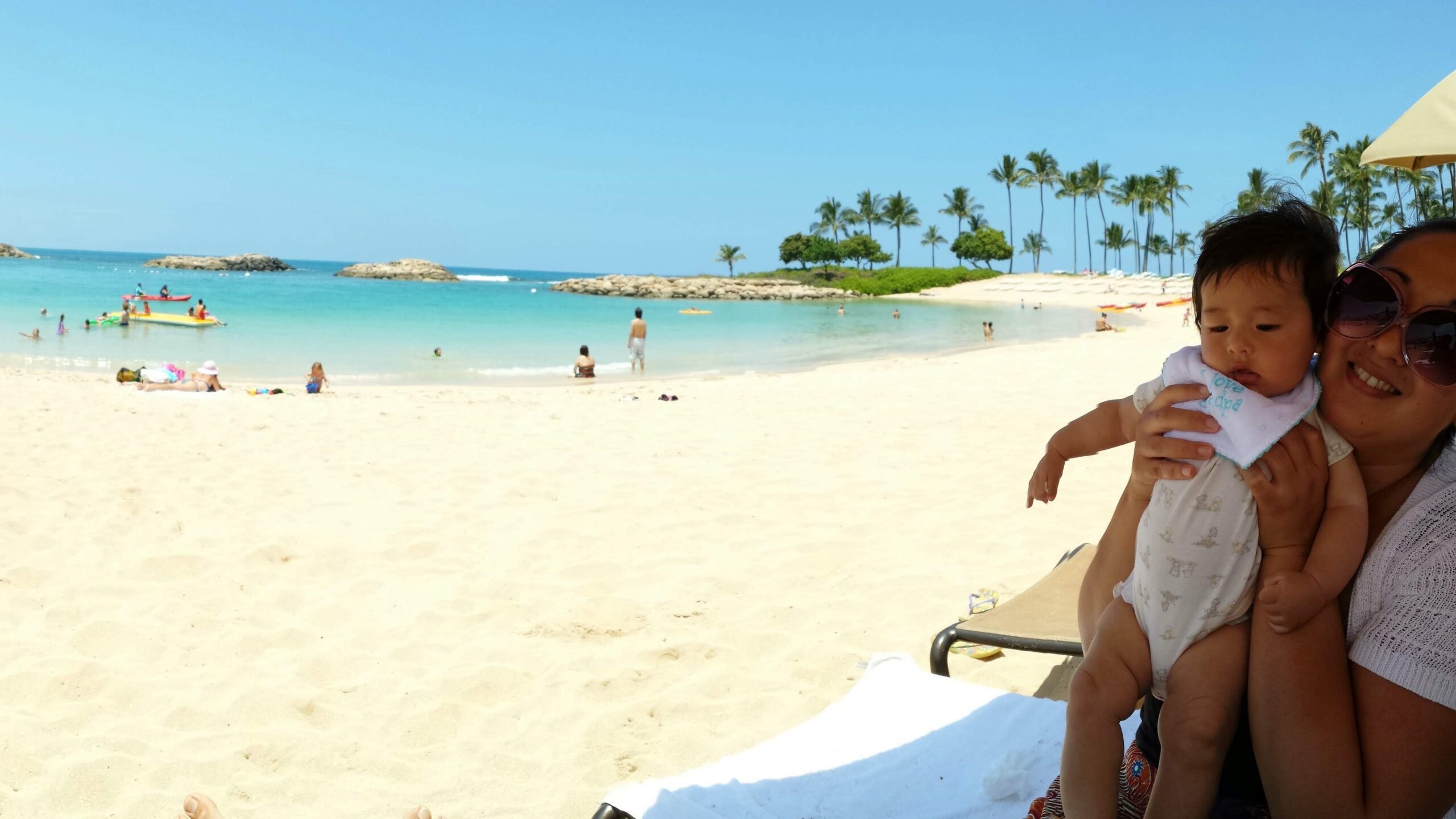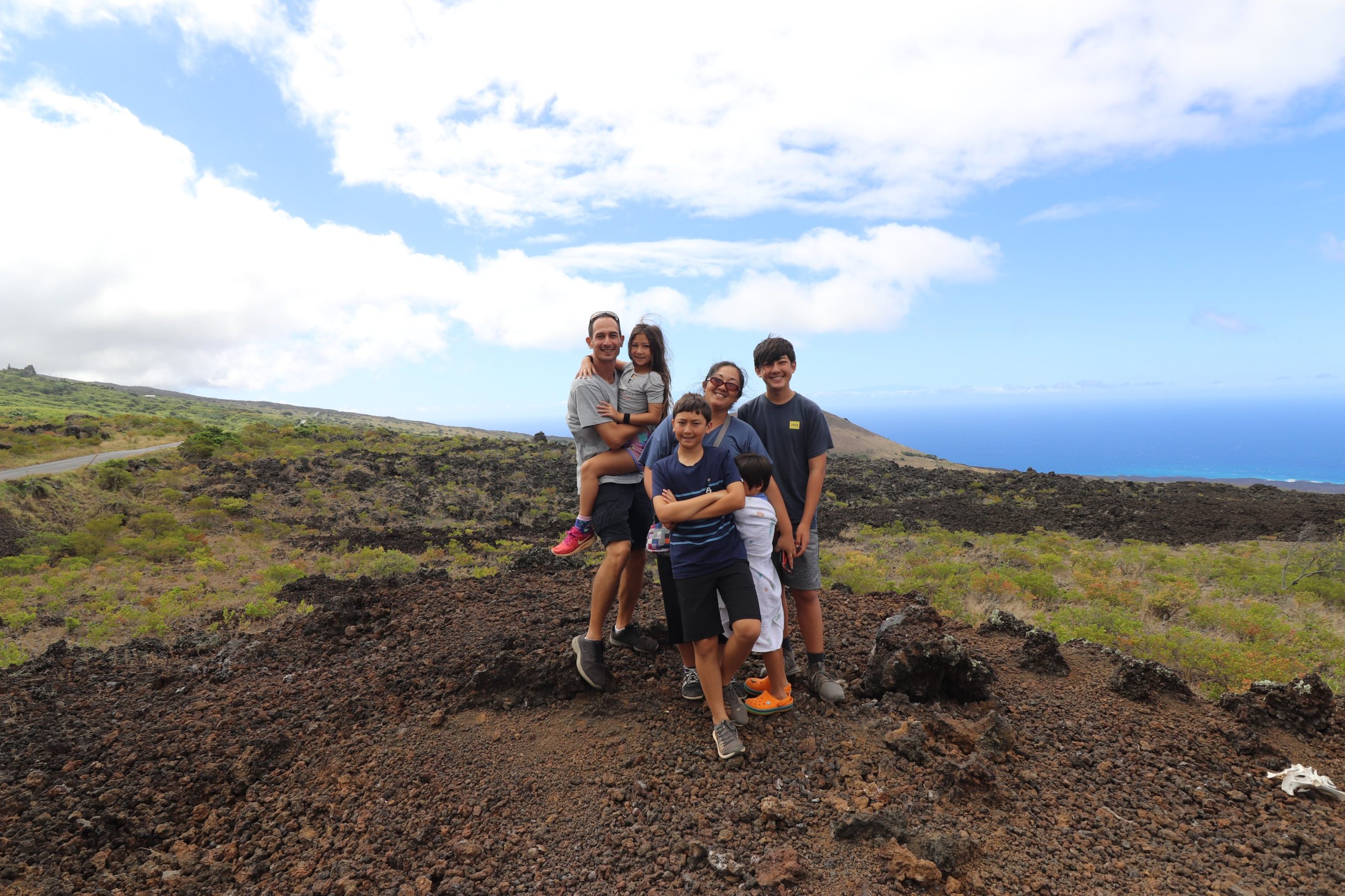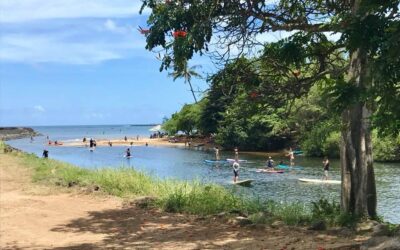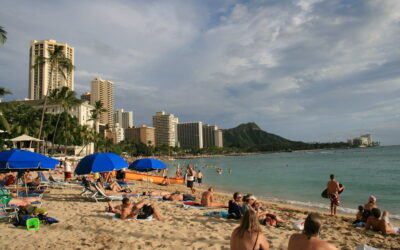Traveling to Hawaii with a baby can be an amazing adventure! Of course, any time you travel with your little one, it’s always helpful to be flexible and resourceful as you prepare for your Hawaii vacation. Hopefully, fingers crossed, this will help create as smooth an experience as possible.
We’ll try to cover everything you need to know: packing essential items, selecting baby-friendly accommodations and restaurants, understanding airline policies, preparing for the flights, and everything else you need to plan your baby-friendly vacation. Also, keep an eye out for additional tips for making the most of your Hawaiian getaway!
Of course, since every child is different, not all these tips will apply, but we hope some of these ideas will help or inspire you as you plan your vacation. If you have any baby travel advice, please share it in the comments below. We all know raising children can take a village, so feel comfortable extending it here! 😊
Preparing for Your Trip
Booking Your Flight
Whenever preparing for travel with an infant or toddler, it’s good to be a little flexible, even if you already have Plans A, B, and maybe C. Since part of your plans depends on where you’re traveling from, make sure to check the actual travel hours and layover times, not just the time you leave and arrive. For example, when we lived in Minnesota, travel time could range from 10 to 12+ hours, depending on whether we had a direct flight or a layover or two. When we travel from East Asia to Hawaii on a direct flight, we often gain a day going to Hawaii and lose a day when we fly back to Asia, but the actual flight times are usually between 9 and 11 hours with a direct flight.
TIP: If you’ve never traveled with your baby, it might be a good idea to try a mini-trip before your Hawaii vacation – like a long day trip or an overnight road trip. Can they sit (mostly) still for hours at a time? Do they have a hard time settling in a hotel room? It will also help you test out if you want to bring bulkier items like a big stroller, pack-n-play, etc., or just rent these bigger items from a local vendor.
Over the years, I’ve had many discussions about whether a family should take a direct flight or a flight with layovers while traveling with little ones. And the answer is [drum roll]...it depends! It’s not a cop-out! LOL. I can honestly say that the right answer depends on your individual personalities, your family dynamic, your child’s temperament, and the age of your children.
Before I had children, I hated layovers. Just stick me in a seat and let me daydream in peace. However, once I started traveling long distances with my babies — “3 kids, 2 years and 2 months apart, not on purpose” — across the US and Asia, I grew to appreciate the breaks between hours-long flights.
Basically, I’m just tossing out some ideas as a mom with other mom friends. With my family, direct flights worked well when the kids were either non-mobile infants or 3 years old or older. By then, they were old enough to enjoy in-flight shows, timed snacks, simple instructions, and take potty breaks. For mobile, active babies and young toddlers, I usually book my flights with one layover as close to halfway as possible for approximately 2 hours, if possible. The 2-hour minimum was for my sanity, in case the first plane was late, in case we needed multiple diaper changes, or in case they needed more food, and just to let them run around a little.
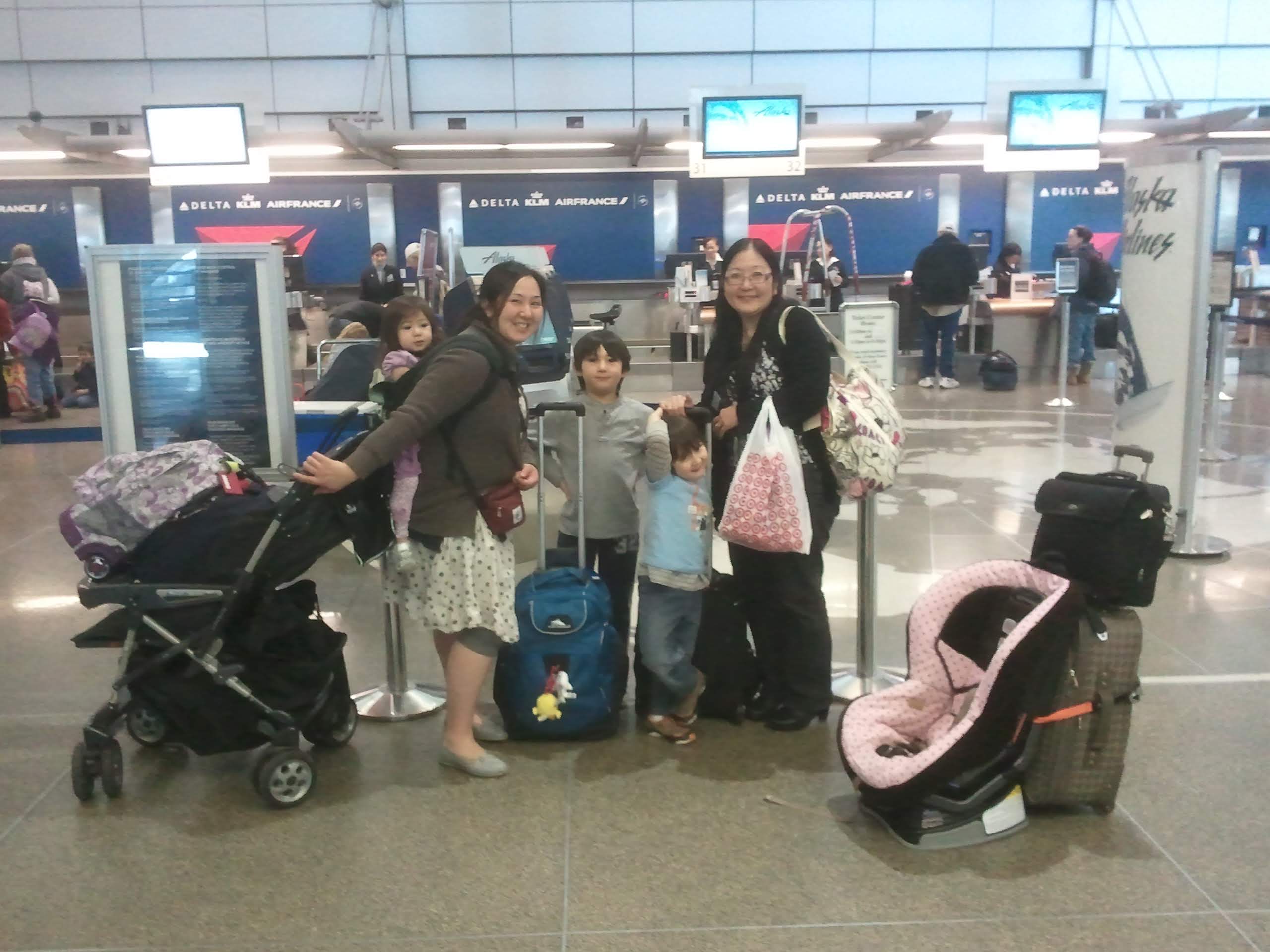
Nowadays, with all the canceled flights, delays, overbooked flights, and more, flying with babies and small children can be exhausting. You know your family best, so just keep your eyes on the prize – a lovely family vacation in paradise!
TIP: If you are comfortable breastfeeding, I have found nursing my babies on the plane was my saving grace. Nothing put my baby to sleep faster than boob food and if they have ear aches from take-off and landing, nursing helps A LOT!
Many airlines offer free or discounted tickets for lap babies, which are available for infants under 2 years old. Please check each airline’s policy for details and required documents. Besides the associated costs, remember to consider the age of the baby and their temperament.
We usually took advantage of the lap baby option, but I also have many friends who bought their baby a seat and used their car seat during flights, as their babies were already accustomed to one. In addition, if you rent a car during your Hawaii vacation, you’ll need a car seat anyway. While many airlines do not require babies to sit in a car seat while on the plane, I’ve found it’s usually easier to keep them comfortable and safe when they have their own seat.
What to Pack for Your Baby
For general packing information, please check out our Hawaii vacation packing guide.
When traveling to Hawaii with a baby, packing the right baby gear can make all the difference in ensuring a smooth and stress-free family trip.
Essential items may include:
- a travel crib
- a stroller
- a car seat
- sunscreen
- comfortable clothing that can be layered
TIP: Pack an extra outfit (or two) for both you and your baby in your carry-on luggage. Spit-up and poopy blow-outs can happen anywhere, and nothing ruins the vacation vibe more than 8 hours in a barfy or poopy shirt (I mean yours too, not just the baby!). LOL.
To keep things simple, consider the following when packing:
- Baby Gear: A compact stroller (ideally with a basket) and a durable, lightweight carrier can make navigating the islands much easier. These essentials provide flexibility for both outdoor adventures and urban explorations.
- Feeding Supplies: Don’t forget to include sippy cups, portable utensils, and plenty of snacks. Having familiar food options can help soothe a restless toddler during long waits.
- Diaper Supplies: If your child is potty training, it may be a good idea to use pull-ups during flights, as you may not always have access to a restroom. Also, although stores like Target, Walmart, and CVS (Longs) are usually available, I recommend bringing a couple of days’ worth of diapers, wipes, diaper creams, and other essential baby toiletry items. That way, at least you’re covered until you have time to make a trip to a store.
- Bring a Power Strip: Nowadays, I always pack a power strip because we all have too many electronic devices. If you have various items that need charging, consider bringing a power strip with outlets and USB ports, as not every hotel room has enough outlets.
- Know Which Island You’re Traveling to: Know the island and the location of the resort you’ll be visiting. If you’re going to Oahu, there are a ton of places to pick up additional supplies if you forget anything. However, if you’re staying at an all-inclusive resort in Kohala on the Big Island, there are fewer places available to grab extra diapers, wipes, and baby food.
- Comfortable Clothing: Pack lightweight, breathable outfits that are easy to layer and quick to change. Hawaii has beautiful weather, but nights are sometimes cool, and we have surprise bursts of rain, even when it’s sunny out!
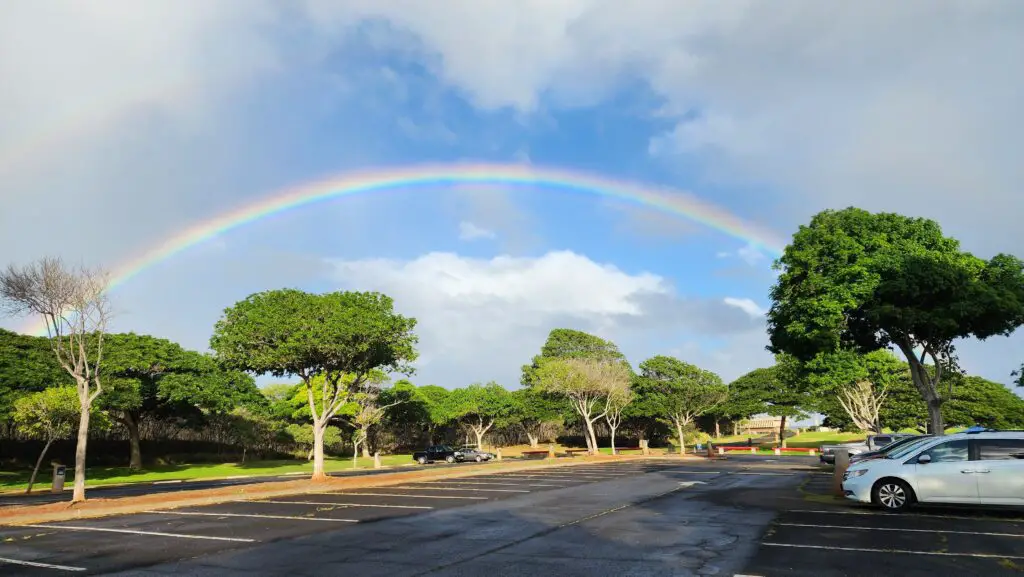
When organizing checked baggage, using packing cubes to keep baby items separate and easily accessible is a very convenient option. This helps to maximize luggage space and ensures that you can quickly find necessary items without the hassle of rummaging through your luggage. I like having packing cubes color-coded to each person to make finding their stuff easier.
Keep in mind that families with infants are often prone to overpacking, or packing the wrong things, because many parents feel compelled to bring things “just in case.” Use your itinerary as a guide while packing for your trip so you aren’t bogged down with 10 unused outfits or a travel crib, pack-n-play, AND inflatable baby bed.
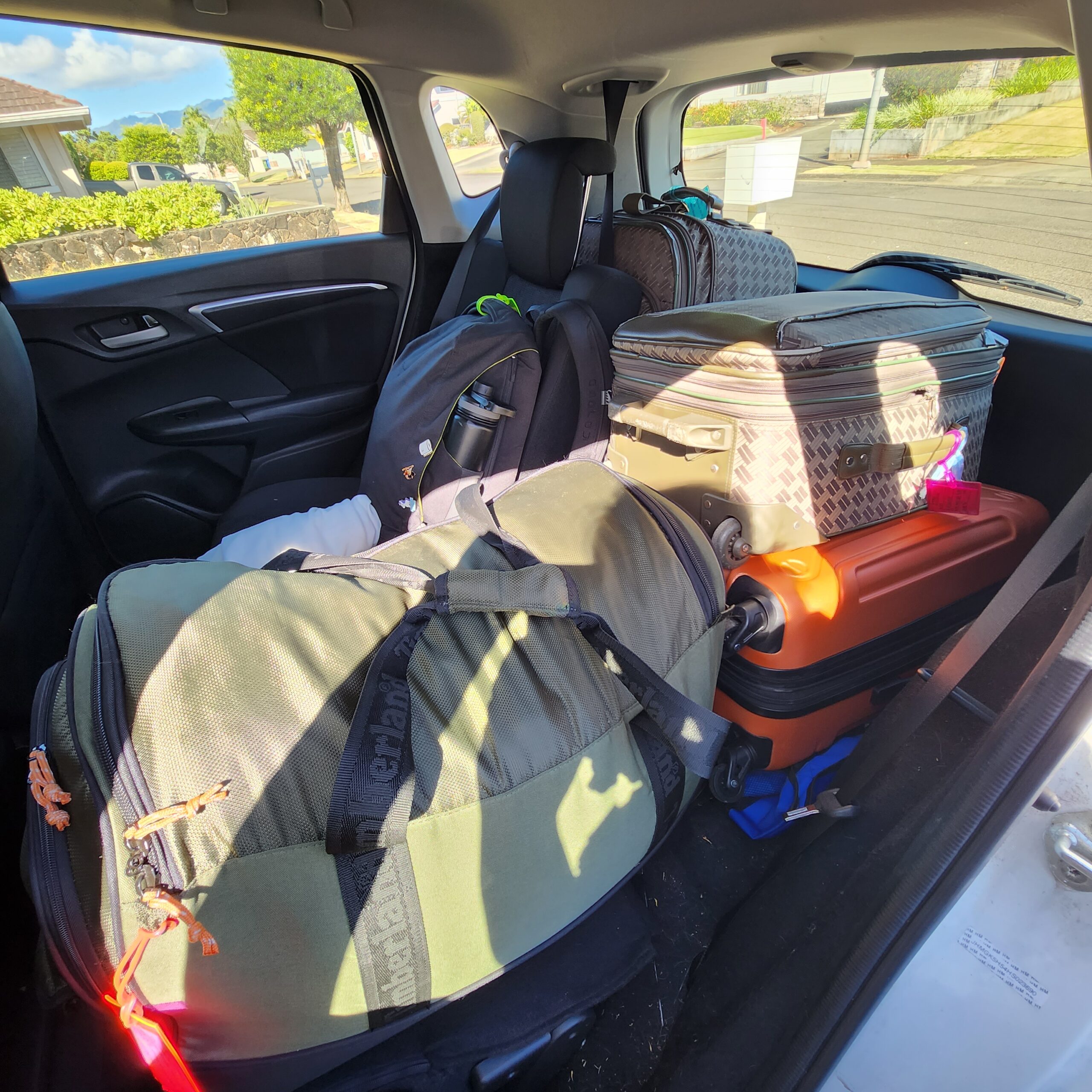
TIP: Consider renting baby gear instead of lugging all your gear from home. Renting on location might prevent your favorite items from getting damaged during airplane travel and save your arms from having to carry all half a houseful of baby gear in and out of airports, taxis, and hotels. Some baby gear rental places also offer options for food and baby supply deliveries as well, but you may need to reserve everything in advance so book these things early!
What to Consider when Choosing Accommodations
Many hotels and resorts accommodate families with ease; however, some locations offer additional amenities specifically designed for families with young children. Aulani, a Disney Resort & Spa, has, in addition to all the Disney-themed activities, beachfront access to Ko’olina Lagoons – these lagoons are four gentle, man-made beaches perfect for children and non-swimmers. Waikiki Hotels such as the Hilton Hawaiian Village and the Royal Hawaiian offer child-friendly pools and restaurants, as well as activities for the whole family. When reviewing potential hotels, check if they offer discounted meals for toddlers and older babies, cribs, high chairs, age-appropriate activities, and/or a kids’ club.
Possible Items to Look for in a Hotel/Resort:
- Do they rent out cribs or bassinets? Is the room big enough to accommodate?
- Do they have a microwave in the room?
- Do they have a mini-fridge in the room?
- How close is the nearest Walmart / Target / Longs (affiliated with CVS) / etc.?
- Is there a bathtub?
- Are there activities for my child at the resort?
- Do the restaurants at the hotel or within the neighborhood offer free or discounted meals for children?
It may also be a good idea to consider aspects such as proximity to parks and beaches, meal planning options, and family-friendly activities. Hotels in Waikiki offer great beaches for small children and beginner swimmers, are conveniently located near the Honolulu Zoo and the Waikiki Aquarium, and are within walking distance of a variety of shops and restaurants. You can also take advantage of The Bus or Waikiki Trolley to visit Chinatown, Hanauma Bay, Sea Life Park, and more.
If you or your child has specific dietary restrictions or requires special food accommodations, please communicate with the hotel staff or the Concierge Desk so they can assist you.
Planning ahead of time and considering the location, amenities, and various needs of your family can help ensure an enjoyable, memorable, and stress-free vacation in paradise.
Check Airline Policies for Babies
When traveling with a baby, understanding airline policies beforehand can help you have a hassle-free experience during your flights to and from Hawaii. Different airlines have varying rules regarding checked baggage and carry-on items for infants, which can affect your travel expectations. Familiarize yourself with these policies in advance to avoid any surprises at the airport.
Airline policies often include specific baggage allowances for infants that can significantly ease your journey. Most carriers allow parents to bring a diaper bag as a carry-on item in addition to standard luggage. Many airlines allow children under two years old to fly for free or at a reduced rate if they are seated on their parents’ laps. In terms of seating options, many airlines allow families to reserve a bassinet on long-haul flights, subject to limitations based on an infant’s weight and length. You’ll need to arrange these in advance, so please check with your airline directly.
When traveling with a baby by airplane:
- Always double-check the specific airline’s guidelines ahead of time.
- Take advantage of pre-boarding privileges offered by many airlines for families traveling with young children.
- Utilize in-flight services such as baby meals when available.
Although you can’t always determine how your baby will react to a long airplane flight, planning can hopefully give you some peace of mind and mental preparation for your journey.
Traveling to Hawaii with a Baby
I have traveled with my children as young infants, toddlers, older children, teens, and a combination of everything in between – including a trip to Asia on my own with my 6-year-old, 4-year-old, and almost 2-year-old. Most of the time, despite setbacks beyond our control, such as flight delays, cancellations, lost tickets, or missing luggage, I have generally had positive experiences traveling with my children.
At the same time, I have had a baby cry non-stop for 2 hours, and I have been on an international flight where someone else’s 1-year-old cried for at least 6 hours of the 8-hour flight.
The bottom line is: do what you can to prepare, but know that sometimes stuff happens and, as you probably already know, that’s life with kids.
From preparing for the airport experience to managing expectations during the flight, it’s a good idea to conduct a mental walk-through to help determine how to make the journey as smooth as possible for you and your child.
How to Keep Your Baby Comfortable on the Plane
Keeping your baby comfortable on the plane trip to Hawaii can be achieved with a few considerations. From choosing the right clothes and packing necessary items to managing feeding and sleep schedules, these factors can significantly contribute to a more enjoyable flight experience. Being aware of airline policies regarding infants can also help you navigate the journey more smoothly.
To enhance the overall travel experience, consider bringing along a few of your toddler’s favorite toys and comfort items, as these can provide a sense of familiarity and security during the flight. Comfort items, such as blankets, plush toys, or a beloved book, can work wonders in soothing a restless child. Having a selection of snacks on hand can keep them occupied and happy; for your sake, choose items that are easy to manage and not too messy.
Some things to consider:
- Consider dressing your baby in easy-to-change, soft, and simple clothing – complicated snaps and buttons, or multi-layered pieces, may be difficult to change in the airplane restroom cubicle.
- If possible, know when to feed your baby to help mitigate hunger-induced crying on the plane – for some, that may mean feeding your baby just before boarding, for others, it may mean making snacks available as soon as you’re seated on the plane.
- If possible, time their naps to coincide with flight times.
- If the schedule allows, utilize layovers for quick breaks to let your child stretch and/or run around.
Ultimately, preparing as best you can usually alleviates most fears associated with traveling with small children. And, hey, even if there are challenges during the journey, you know you did your best to make the trip as smooth as possible.
TIP: If your baby is fussy due to changes in altitude on planes and is too young for chewing gum or lollipops to alleviate ear pressure pain, drinking from a bottle, breastfeeding, or using a pacifier when the plane is ascending or descending can help reduce their discomfort and (hopefully) prevent scream-crying at take-off and arrival. (It happens 😓).
What to Expect at the Airport and During the Flight
Navigating the airport with a baby in tow can be an adventure, but knowing what to expect can make the experience less stressful for your flight to Hawaii. From security checks to boarding processes, familiarize yourself with airline policies that specifically pertain to traveling with infants and small children to streamline your airport experience. Being prepared for potential baby-related situations and having a plan can also help alleviate stress as you board your flight.
It’s essential to allow extra time for each stage of the airport experience. Beginning with the check-in process, many airlines offer family-friendly procedures that accommodate parents traveling with infants, such as priority boarding.
Ensure that all essential items, such as diapers and snacks, are easily accessible to minimize delays. If you’re using a baby carrier or stroller, you often have to remove the baby and all items from the stroller when going through security checks.
- Check-in: Use online check-in services if possible to save time.
- Security: Expect to remove baby food and milk during screening and notify the TSA in advance.
- Boarding: Take advantage of family boarding, which usually happens before general boarding begins.
- In–Flight: If possible, try to sleep or rest when your baby sleeps; it may help you stay clear-headed once you arrive in Hawaii, even if your baby is fussy or experiencing jet lag.
Consider bringing a lightweight stroller or baby carrier to help you navigate the terminal more easily. Being prepared for unexpected occurrences, such as diaper changes or sudden fussiness, can make even potentially stressful situations easier to manage.
How to Handle Jet Lag with a Baby
Jet lag with a baby or young child after arriving in Hawaii is hit or miss. Sometimes my children didn’t experience it at all, other times they were wired and wide awake at 2 AM. Having some strategies in place might ease the adjustment for both you and your baby.
To help effectively tackle jet lag for your baby, consider these strategies whenever applicable:
- Gradual Adjustment: Start shifting your baby’s sleep schedule a few days before departure. Gradually moving bedtime closer to the destination’s time will ease the transition.
- Natural Light: Upon arrival, expose your baby to natural sunlight during the day to help reset their internal clock. This is especially important in the morning hours.
- Meal Timing: Serving meals according to the new local time can signal to your baby’s body that it’s time to adjust. Staying consistent with mealtimes will help reinforce this new schedule.
- Calming Environment: Once settled in your accommodation, create a sleep-inducing atmosphere by dimming the lights and reducing noise levels. This tranquility encourages deeper sleep.
Finding and implementing these kinds of strategies can help both you and your baby adjust to Hawaii Time more quickly, allowing you to all enjoy your Hawaii vacation from Day 1.
TIP: More people experience jet lag traveling from west to east. For most US travelers, you’ll be traveling east to west when traveling to Hawaii, so jet lag going on your vacation to Hawaii might not be too bad (but on the flip side, it might be more difficult as you head back home going east).
Exploring Hawaii with a Baby
Exploring Hawaii with a baby can be an enriching experience for the entire family, allowing them to discover the sights and sounds of the Hawaiian Islands. Hawaii offers numerous destinations that you can enjoy with your young children – from stroller-friendly hikes and walking paths to beautiful beaches and family-friendly events and activities. Your family has a wide range of options to consider when planning a vacation in Hawaii.
Best Places to Visit with a Baby in Hawaii
When planning your family trip, knowing the best places to visit with a baby in Hawaii can enhance your experience and create lasting memories. It’s a good idea to research the island(s) you’re planning to visit and see what’s available, and also what you’re willing to do with a baby or young child in tow. On Oahu, destinations like the Waikiki Aquarium, Honolulu Zoo, or Waikiki Beach offer baby-friendly activities and calm waters for you and your young child to explore and play. Sea Life Park and Polynesian Cultural Center also offer a full day of activities for toddlers and older children. Additionally, many hotels in Waikiki and Disney’s Aulani offer in-house activities for children.

On the island of Maui, the Maui Ocean Center offers interactive exhibits designed for young children, ensuring that little ones are both entertained and engaged.
Most shopping centers and tourist areas in Hawaii provide the following:
- changing tables
- nursing spaces near restrooms
- children’s play areas
If you’re interested in hiking with your child, the Makapu’u Lighthouse Trail offers a paved path perfect for strollers, with amazing ocean and southside views. During the winter, we have even caught whales shooting water through their blowhole, too! However, please note that there are restrooms on site.
Check out our list of easy and child-friendly hikes to find one that suits you and your family.
If you have an infant who’s comfortable in a carrier (and you are willing to wear it), it’s possible to do most activities that adults or families with older children can do – hiking, visiting historic sites and museums, exploring botanical gardens, and more. Of course, it will depend on your baby’s temperament – with our oldest, we just put him in a carrier and went everywhere with him.
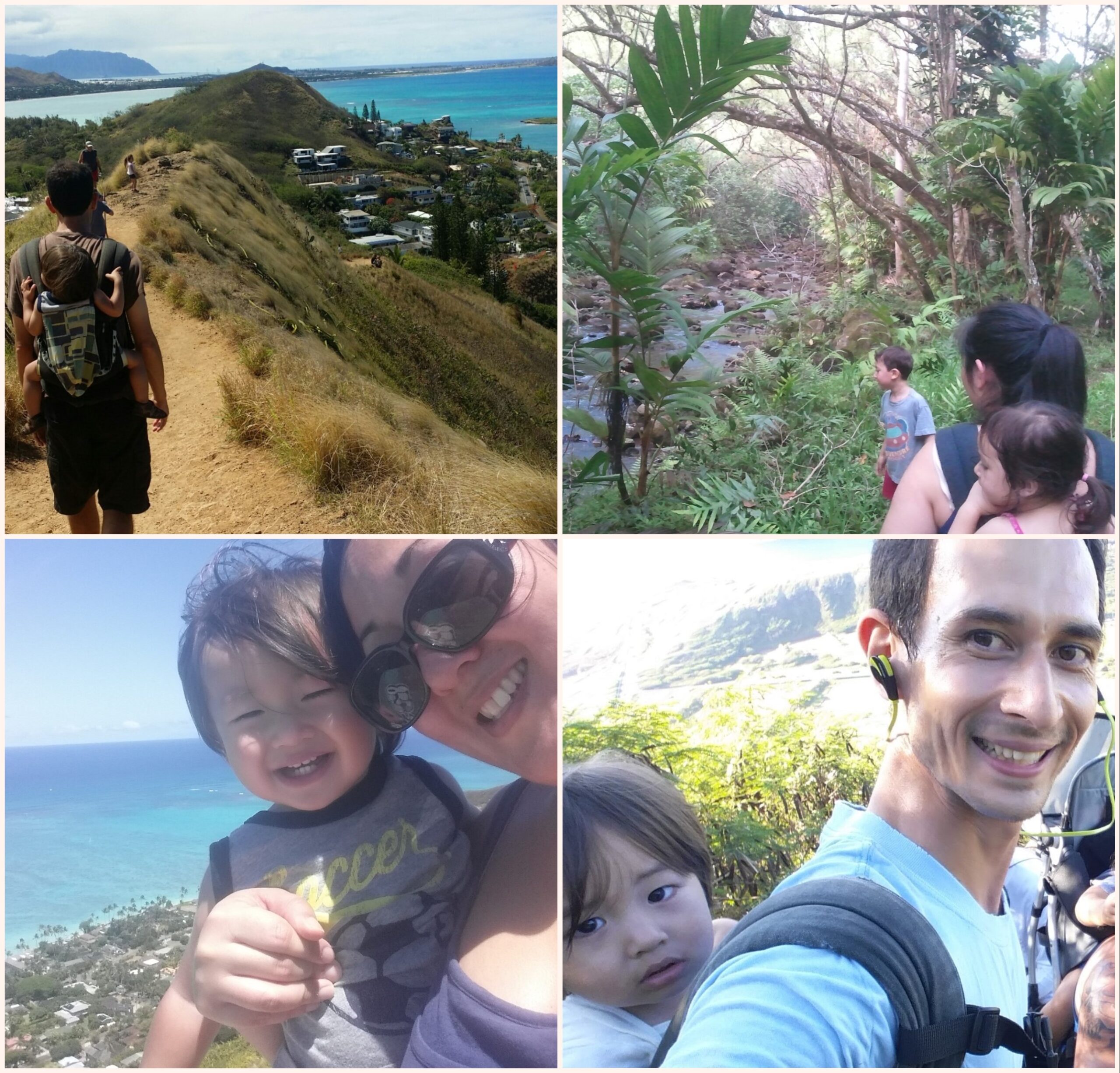
TIP: If you plan to visit Hanauma Bay or Diamond Head Trail, please note that you’ll need to register and pay for entrance fees online in advance. Many times, especially during heavier tourist seasons, reservations may be booked a couple of weeks in advance.
How to Keep Your Baby Safe in the Sun and Water
Keeping your baby safe in the sun and water is paramount to ensuring a fun and enjoyable Hawaii family vacation. It’s essential to apply sunscreen regularly on both you and your baby – the UV rays are pretty intense in Hawaii. Additionally, ensure that everyone stays hydrated to prevent heat exhaustion or sunstroke.
Hawaii has regulations on the types of sunscreens available for purchase on the islands – this is to protect our coral reefs and marine life from damage caused by certain chemicals found in popular sunscreens. Because of this, Hawaii offers a variety of skin-friendly and baby-friendly options that typically contain fewer chemicals and provide stronger SPF protection. If you already have sunscreen purchased at home, you can bring it to the islands; however, please note that certain chemicals are already causing significant damage to our island’s sea life, and some of these sunscreens may contribute to the problem – try to avoid sunscreens containing oxybenzone or octinoxate. If you do bring sunscreens from home, please make sure they are SPF 50 or higher. Lower SPF sunscreens are simply not strong enough to protect your skin from Hawaii’s UV rays. Also, make sure to reapply sunscreen at least every 1.5 to 2 hours.
For more information about sunscreens and Hawaii, please check out our article on reef-safe sunscreens.
If you plan to be outdoors all day, be sure to monitor your baby for signs of heat exhaustion, which may include symptoms such as excessive fussiness, lethargy, or unusual skin color. Seek medical care if necessary.
TIP: It is usually recommended to avoid outdoor activities during the hottest times of the day – unfortunately, in Hawaii, the “hottest times of the day” are typically listed as 10 AM to 4 PM. << Okay, this advice always frustrated me, I mean 10 AM to 4 PM is ALL DAY! Practically speaking, I would do a mix of activities during the day, where I can spend some time in the shade, in a building, or in a car/bus and then just reapply sunscreen before stepping outside – e.g. a hike outdoors, then an indoor restaurant for lunch, followed by a visit to Pearl Harbor Memorial where there are both indoor and outdoor activities.
Here are some suggestions to keep baby (and family) sun-safe:
- Hydrate: Always offer plenty of fluids—breast milk or formula for infants, and water or electrolyte solutions for older babies.
- Safe Swimming Practices: Invest in a baby swim vest or floaties to support your little one and never leave them unattended near water. If you are not a good swimmer, go to shallow, calm beaches – Waikiki Beach, Ala Moana Beach Park & Magic Island, Ko’olina Lagoons.
- Apply and Reapply Sunscreen: If you are in the water, remember that the reflective surface intensifies UV ray exposure. When at the beach or pool, reapply sunscreen every hour to prevent severe sunburns (even with regular sunscreen applications, people with fair skin may still turn pink or flushed due to Hawaii’s intense UV rays, we just don’t want you turning into a lobster 🦞.)
By being vigilant and proactive, families can significantly reduce risks, making those sun-kissed moments truly enjoyable.
For more information on Hawaii safety tips, please check out our article on practical safety tips to utilize while on your Hawaii vacation.
Where to Find Baby-Friendly Services in Hawaii
Help can come in all forms, and finding baby-friendly amenities in Hawaii can significantly ease the experience of traveling with a baby. Take advantage of baby gear rentals, family-friendly activities, and other baby-friendly goods and services to help make your Hawaii vacation more relaxing and stress-free.
Utilize Hawaii’s baby and family-friendly goods and services:
- Rental Services: Look for companies that specialize in baby gear rentals. They offer items such as cribs, high chairs, and toys to ensure families have everything they need without the hassle of bringing it all. Some also offer grocery and product deliveries!
- Family-Friendly Restaurants: Many eateries are accommodating to families, providing high chairs, kids’ menus, and diaper-changing facilities. Call ahead or check online reviews for recommendations.
- Local Attractions: Research attractions and locations that offer features such as shaded areas, stroller-friendly paths, child play areas, and facilities for feeding and changing.
Planning will help you maximize the services available (since some require reservations) and minimize the stress of last-minute arrangements, making a more enjoyable experience for the entire family.
Baby Gear Rentals
Baby gear rentals in Hawaii offer convenience and flexibility for families traveling with infants and toddlers, allowing you to travel light and enjoy your family trip without the hassle of bringing all the bulky items from home.
Look to Yelp for a list of recommended baby rental gear options and reviews. Although many of these were not available when my children were babies (plus, I have family in Hawaii to house specific items), there are now a variety of vendors offering gear rental, personal shopping, and more. Let them provide the gear and baby goods you need so you can truly enjoy your vacation!
TIP: In addition to baby gear, consider rental services if you’re planning on snorkeling, surfing, stand-up paddle-boarding, or anything that requires additional equipment.
Utilizing local rental services not only supports the local economy but also contributes to a more sustainable travel experience by reducing waste from unnecessary one-time purchases left behind after vacations are over (this happens often).
Tips for a Smooth Trip with a Baby
Parenting is often a balance between expectations and reality. However, despite what additional adventures might come up with having a baby on board, I have always been a firm believer of planning what we want to do, knowing that a fussy baby, sunburnt Dad, or poopy blow-out might derail even the best laid plans. Usually, when traveling to Hawaii, some planning is necessary, as a few popular tourist sites may require advance reservations. It might also be a good idea to have a few child-friendly food spots and activities penciled in beforehand, so you don’t have to Google search these items when you’re hangry or in a rush to leave the hotel. Having a plan for emergencies can also provide peace of mind while exploring the islands.
Where to Find Baby-Friendly Restaurants
When traveling with younger children in Hawaii, I have found that most restaurants and eateries are friendly and accommodating for families with small children. If there are any “less accommodating” locations, it’s usually their space and logistics that make it so, not the people. For example, I recently visited a popular place in Haleiwa, and they only had ONE high chair in the entire restaurant. Part of the reason, however, was that it was just a small venue. In fact, even navigating the space with a stroller was a little tricky if we didn’t want to block the waitstaff from delivering food to tables or have a stroller handle digging into the back of another customer. In the end, it worked out for us because my 1-year-old niece really enjoys – and will happily wait for – food, but I could see it being an issue if you had a wiggly toddler.
In any case, finding baby- or family-friendly restaurants depends on what you’re looking for: highchairs, chicken nuggets on the menu, special menus just for children, or just a place that can accommodate a full-sized stroller with a hungry baby, etc.
Overall, Hawaii’s diverse culinary scene includes many options that cater to families traveling with babies. If your baby can eat table food (i.e., eat what you eat), most restaurants offer a variety of options. However, if you need to heat food that you’ve brought, I recommend calling or checking in advance. When in doubt, I highly recommend checking the menus online, reading reviews, or giving them a call.
TIP: Due to Hawaii’s variety of cultural foods, another concern would be if you or your baby have specific allergies. We have shellfish and nut allergies in our family and it’s something we must check into no matter where we travel. If you have food allergy concerns, make sure you check in advance whether the restaurants have options to fit those needs. Most popular eateries and chains will have clear menus with dietary indicators and allergens listed, but some true hole-in-the wall locations (as in not frequented by tourists) may not have things as well labeled. This is from personal experiences.
How to Manage Feeding and Napping Schedules
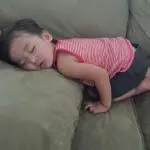
In our experience, when traveling with a baby, I had to always remember that my travel pace wouldn’t be the same as before having children…unless I wanted a full-blown meltdown somewhere during our trip. Ha.
For younger babies, managing feeding and napping may be as simple as nursing or bottle-feeding them between places you’re visiting and just allowing the baby to nap in a stroller or against you in their carrier. However, if you or your baby must nap in a cool hotel room or eat at a table, then establishing a schedule for your trip and having a list of go-to restaurants might be a good idea to keep everyone happy and comfortable.
Here are some things to consider:
- Factor in Time Zones: Adjust your baby’s feeding and napping times gradually before departure to ease the transition. This can prevent potential meltdowns and help everyone adjust more smoothly upon arrival.
- Embrace Flexibility: Be prepared to adjust your schedule according to your activities. If you plan to explore a popular attraction, try to coincide naps with travel time or downtime in shaded areas.
- Pack Essentials: Don’t forget snacks and comfortable sleeping gear. Bringing familiar items can create a more familiar environment that encourages rest.
Babies are usually pretty resilient, and they just might adjust faster than you expect! If not, don’t worry! Either all of you will adjust soon enough, or at least you’ll have memories to share with your friends and family when you return home.
What to Do in Case of Emergencies
It can be frightening when you’re far from home and you encounter an emergency situation while on vacation. Being prepared for emergencies while traveling is crucial, so you have the necessary documents and information if an emergency should arise. Have a list of emergency contacts (someone traveling with you and someone at home). Also, familiarize yourself with local healthcare options and know how to request a first aid kit from your hotel if needed. Keep your documents in a safe place. Knowing where to go and who to contact in case of emergencies can provide peace of mind during your vacation.
When traveling with infants and children, it’s probably a good idea to keep a basic first aid kit with you, along with a list of emergency contacts, allergies, and any critical health conditions. Ensure that your first aid kit is stocked with essential supplies, including band-aids, antiseptic wipes, adhesive tape, infant pain relievers, and any medications your baby may need. Knowing the location and operating hours of the nearest medical facilities can make all the difference in stressful situations.
In case an emergency arises, it might be a good idea to have this information on hand:
- Personal Information: Include personal medical information, such as allergies and chronic conditions, as well as emergency contact information and medical insurance details.
- Travel Insurance: It may be a good idea to consider travel insurance; there are various low-cost options that can supplement your current coverage.
- Hospitals and Urgent Cares: If you have family members with chronic conditions or allergies, it may be a good idea to jot down the nearest hospitals and urgent care facilities near your location (or around the island if you’ll be traveling much).

Even if you don’t have any medical conditions, simple things like a jellyfish sting, getting cut by coral, or catching a cold or the flu might lead to a doctor’s or hospital visit, so keeping important information nearby is a good preventive measure. By taking these steps, families can navigate any health-related hiccups with peace of mind and focus on a fun, worry-free Hawaii vacation.
Frequently Asked Questions (or Notes)
Quick List of My Top Fave Baby/Child Clothing Stores (Oahu)
If you’re looking for Hawaii-themed or Hawaii-print clothing or toys, here are some places that offer fun, local designs.
- Growing Keiki in Haleiwa, Oahu
- Taj Clubhouse at Ward Centre in Honolulu, Oahu
- Wimini Hawaii in Honolulu, Oahu
- Uniqlo Hawaii at Ala Moana Shopping Center in Honolulu, Oahu << Uniqlo in Hawaii has local designs too!
Online Store: Coco Moon << Their clothes and blankets are really, really soft ❤️
What are some quick tips for traveling to Hawaii with babies?
- Baby Supplies: You can pack diapers and wipes for your Hawaii vacation (sometimes I do this because then I’ll have more space to bring back more Hawaii souvenirs 😉); however, most of the time, you won’t need to. The need for extra supplies usually depends on: 1) whether you’re renting a car, and 2) where your hotel is located. If you’re on Oahu, there are Walgreens, Longs (CVS), Target, and Walmart stores all over the island. If you have a car, you can order and pick up supplies on your way to the hotel. I would ask your hotel if there is an option to ship or deliver items directly to your room. On the other hand, you may want to bring supplies from home if your accommodations are in a rural area or within out-of-the-way resort complexes. Secluded resorts are often gorgeous and all-inclusive regarding food and entertainment, but the stores nearby can be unnecessarily expensive and/lacking in baby supplies. Several baby gear delivery services have grocery deliveries, but you must schedule those in advance.
- Favorite Gear: My favorite gear for traveling is my Ergo carrier and a quick-fold stroller, preferably one with a basket. I would often use these items exclusively while visiting Hawaii or exploring various locations around the islands. **NOTE: Bring or rent an age-appropriate child or booster seat if you are renting a car during your vacation. Here is a link to the Department of Transportation for the most up-to-date information on determining if your child is required to use an infant or booster seat.
- Must-Have Item: Sunscreen. Don’t forget to pack (or buy) sunscreen and a hat to protect your baby’s delicate skin from the intense Hawaiian sun. I would also consider UV-protective clothing to protect their arms and legs if you plan to engage in many outdoor activities.
- Don’t Start New Things: DO NOT start things like potty training, nighttime sleep training, or anything extra that may further disrupt the baby’s schedule before your vacation. An 8+hour flight and 2-week vacation is probably not the time to stop breastfeeding, start potty training, or begin pacifier-weaning.
Are there any specific safety precautions I should take when traveling to Hawaii with a baby?
- Sunscreen & UV Protective Clothing: If you haven’t noticed, I’m going to strongly emphasize sun care safety repeatedly. I have seen too many infants and children with unnecessary, painful, and blistering sunburns because their parents don’t exercise proper sun protection care.
- Practice Water Safety: Never leave your infants or children alone in the water. Even if they are in a flotation device, DO NOT LET GO. I have experienced that even the gentlest of currents can sweep an inflatable ball, raft, or floatie out to sea if you’re not careful. In addition, waves, even small ones, can knock down a baby sitting on the sand near the water.
- Stay hydrated: Keep yourself and your baby hydrated to prevent heat-related illnesses. Hawaii often has lovely tradewinds to keep temperatures tolerable however, that often means it’s easy to forget to stay hydrated. For children who play outdoor sports or swim in Hawaii, this is frequently the cause of dehydration – the wind is refreshing and the water is cool, so it’s difficult to realize that you are getting dehydrated until you feel a little sick (heat stroke).
What are some ways to make traveling with a baby to Hawaii more enjoyable?
- Be Flexible: I just spent 10 days traveling overseas with a big family group, including two toddlers. One could nap in her stroller and sit still on the tour bus, the other had to eat noodles every meal and scream-cried unless she could walk around. One wasn’t better than the other, but their personalities (even as newborns) were just different, so they traveled very differently! Depending on your baby’s age and temperament, you may be able to do everything you want on your Hawaii vacation, or you may have to compromise. It’s okay. Part of traveling with your baby is taking the time to enjoy Hawaii and create memorable moments with your family, even if those memories include throwing up on Dad’s head while sitting on his shoulders (our son as a toddler ~ remember, Honey?).
- Plan for Breaks: Make sure to take the time to rest, for the baby and yourself. It’s not always easy trying to remember everything for everyone, and that can take a toll on your vacation experience as well. Plan for breaks!
- Vacation Rentals: If you would like a little more privacy or access to amenities like a fridge, microwave, stove top, etc., consider renting a vacation rental instead of a hotel room. You’ll often have more space for the baby and more flexibility with food since you’ll have access to a kitchenette or kitchen.
Is it necessary to bring a car seat when traveling to Hawaii with a baby?
- Hawaii has specific regulations requiring children under 10 to be properly seated in all motorized vehicles. If you do not want to bring your own car seat or booster chair, several local baby gear rental sites offer up-to-date car seats and other baby gear. You will need to reserve everything in advance, especially if you’re visiting during a high tourist season.
*Usually, buses or shuttles to and from the hotel do not require a car or booster seat, but you will need to hold the infant in your lap.
- If you plan to rent a car, many car rental companies offer car seats for an additional fee; however, be sure to check if the size is suitable for your child. You can also rent baby gear, including car seats, from local baby gear rental companies; however, scheduling is required in advance, especially during high tourist seasons.

